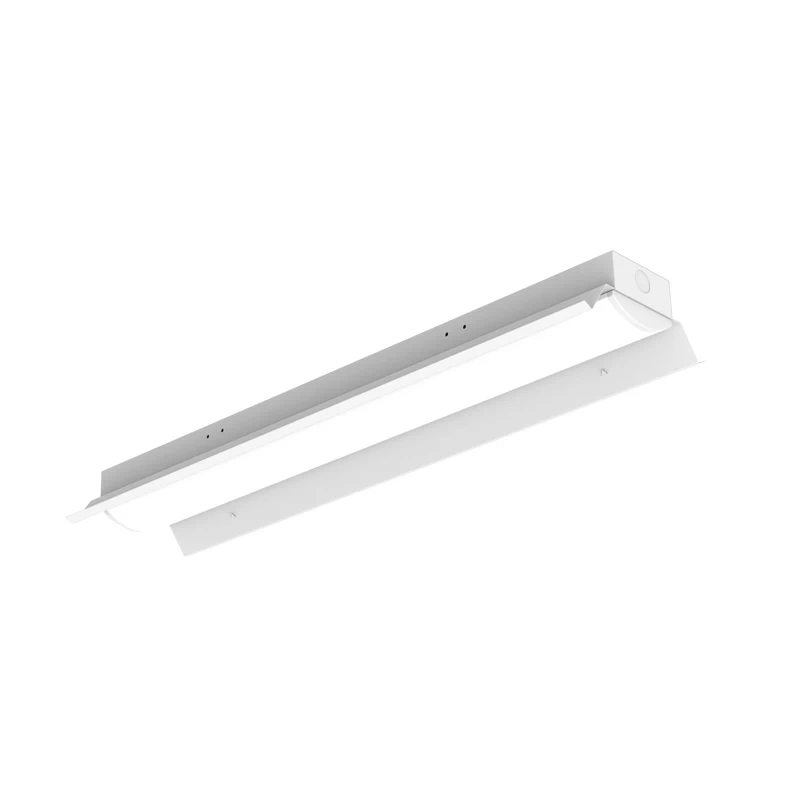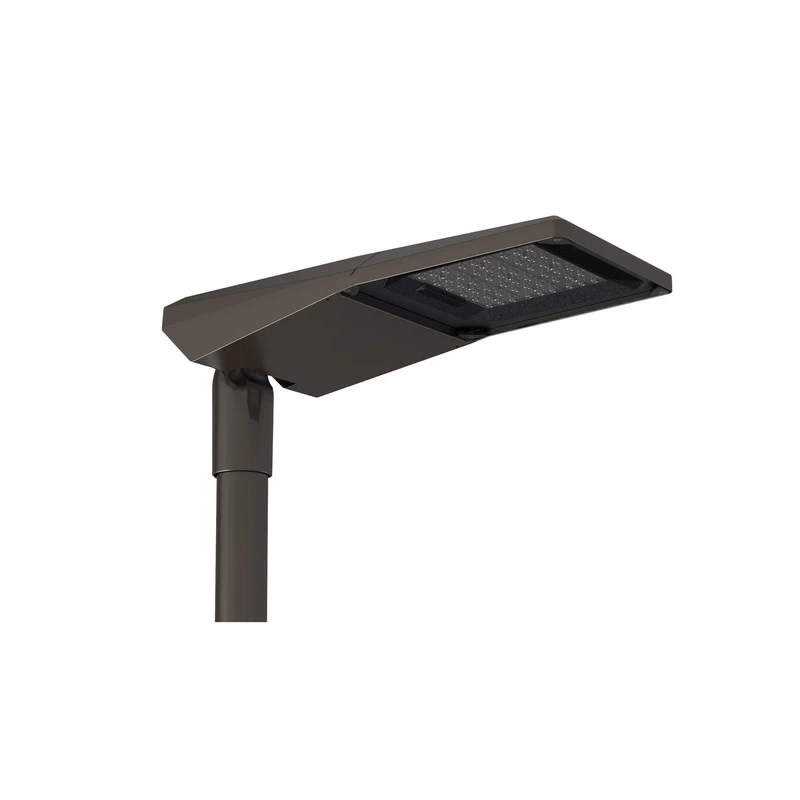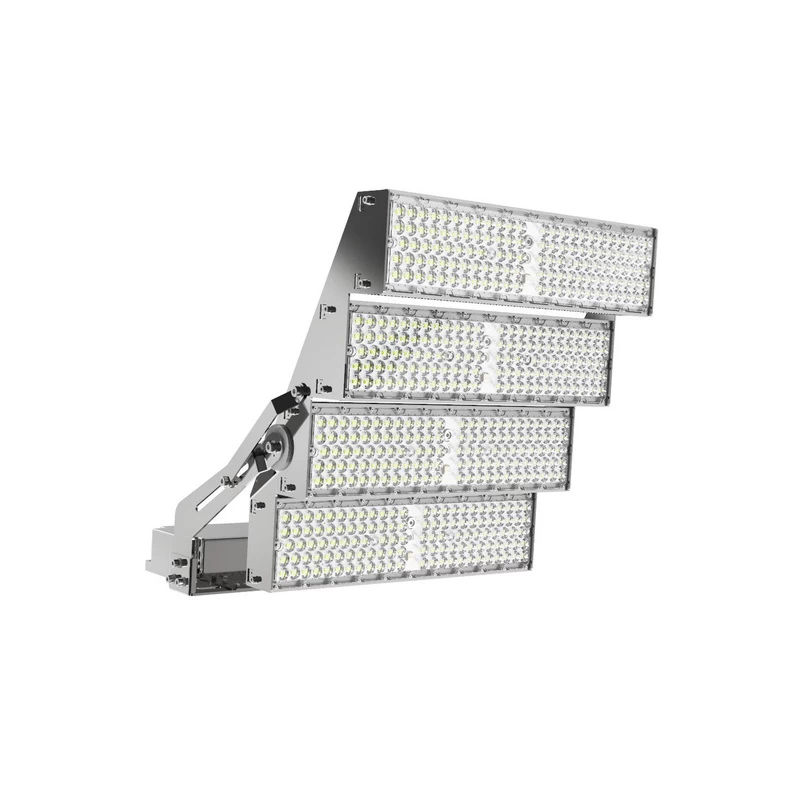목차
토글소개
시간이 지날수록 조명의 밝기가 어두워지는 이유가 궁금한 적이 있나요? 또는 왜 일부 조명 시스템은 다른 조명 시스템보다 더 자주 유지보수가 필요한지 궁금하신가요? 조명 유지보수 요소의 개념을 이해하면 해답을 찾을 수 있습니다.
조명기구는 집, 사무실, 창고, 거리 등 일상 생활에서 중요한 역할을 합니다. 하지만 조명이 최적의 성능을 발휘하고 적절한 양의 조명을 제공하려면 유지 관리에 주의를 기울여야 합니다.
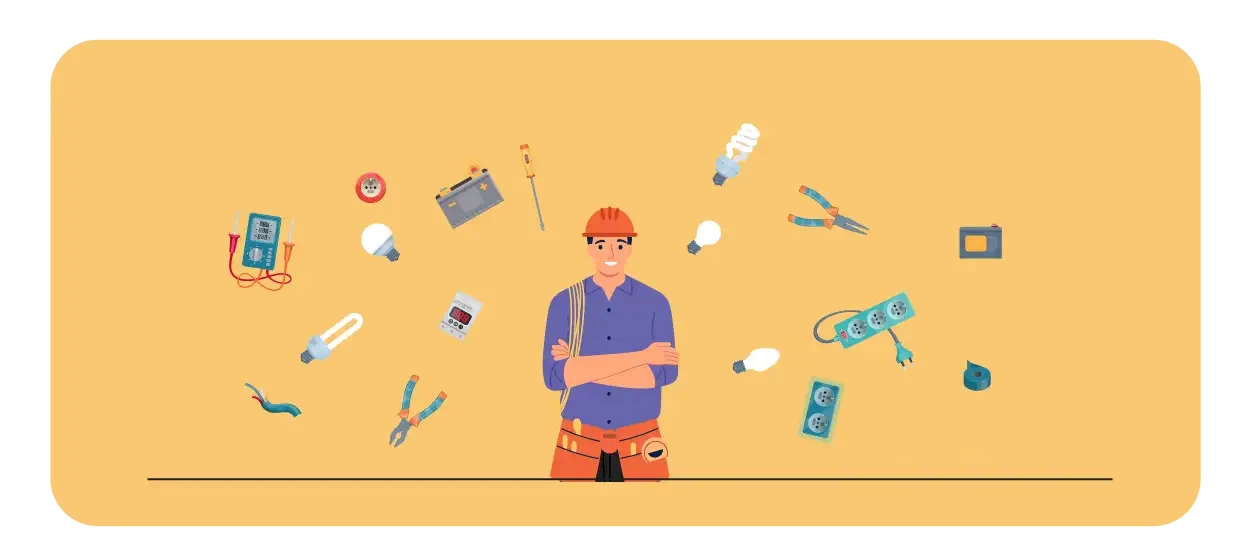
유지보수 램프의 역할
조명 효과 보장
- 램프는 사용 중에 먼지, 기름, 거미줄 등의 이물질이 쌓여 빛 투과에 영향을 줄 수 있습니다.
- 전등갓과 반사 표면을 정기적으로 청소하면 조도를 회복하고 균일한 조명을 확보할 수 있습니다.
조명 품질 유지
- 램프 내부 또는 램프 튜브의 노후화로 인해 빛의 색이 변하거나 눈부심이 증가할 수 있습니다.
- 유지보수를 통해 빛의 색상 변화를 늦추고 편안하고 일관된 조명 환경을 유지할 수 있습니다.
램프 수명 연장
- 램프 내부에 먼지가 쌓이면 열 방출이 제대로 이루어지지 않아 LED나 램프 튜브의 열 부하가 증가하고 수명이 단축될 수 있습니다.
- 냉각 시스템, 배선, 램프 구조를 정기적으로 점검하면 장비의 수명을 연장할 수 있습니다.
안전성 향상
- 먼지가 쌓이거나 램프가 손상되면 합선이나 화재가 발생할 수 있습니다.
- 배선, 램프 홀더, 하우징을 정기적으로 유지보수하고 점검하면 안전 사고를 예방할 수 있습니다.
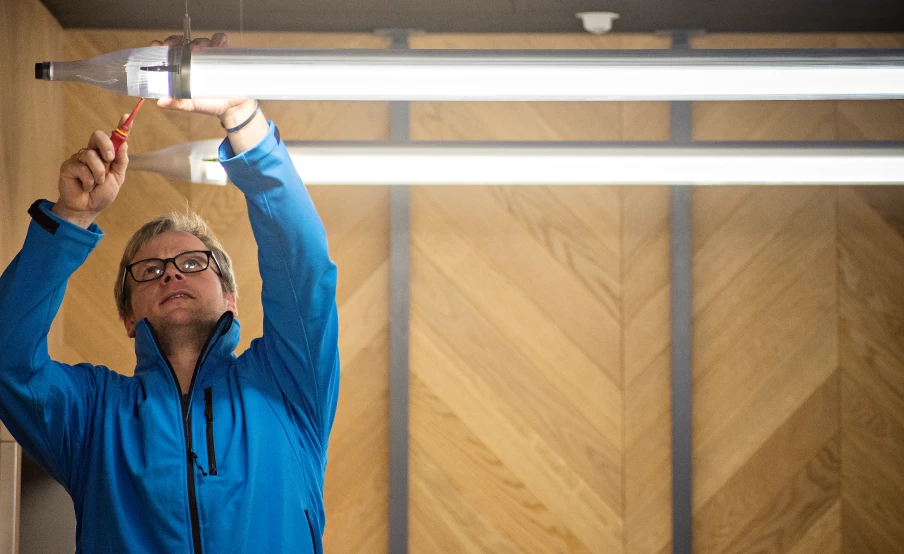
조명 유지보수 요소 이해
그렇다면 조명 유지보수 요소란 정확히 무엇일까요? 이는 먼지 축적, 램프 루멘 감가상각, 부품 노후화 등 다양한 요인으로 인해 시간이 지남에 따라 광량이 감소하는 것을 고려하는 핵심 지표입니다.
유지 관리 계수는 조명 출력이 얼마나 감소할지 예측하고 필요한 유지 관리 또는 교체를 계획하는 데 도움이 됩니다. 조명 유지 관리 계수의 기본 계산 방법은 다음과 같습니다:
- 조명 유지 관리 계수 = 사용 기간 후 평균 조도/초기 평균 조도
예를 들어 조명 시스템의 초기 평균 조도가 1000룩스이고 일정 기간 사용 후 평균 조도가 800룩스인 경우 조명 유지 관리 계수는 800 / 1000 = 0.8이 됩니다.

유지보수 계수의 변화에는 여러 가지 요인이 영향을 미칩니다. 중요한 요인 중 하나는 사용되는 램프의 유형입니다.
- LED와 같은 일부 램프는 기존 램프에 비해 루멘 유지 관리가 더 우수합니다.
- 환경도 중요한 역할을 합니다. 먼지가 많거나 더러운 곳에서는 조명기구에 먼지가 쌓여 빛의 출력이 더 빨리 감소할 가능성이 높습니다.
- 구성 요소의 품질과 조명 시스템의 초기 설계도 유지보수 요소에 영향을 미칩니다.
유지 관리 계수 계산
유지 관리 계수를 보다 정확하게 계산하려면 다음 요소를 고려해야 합니다:
- 램프 루멘 감가상각: 램프의 종류(예: LED, 형광등, 백열등 등)에 따라 사용 중 광 출력 감쇠 정도는 다양합니다. 램프 제조업체에서 제공한 루멘 감가상각 곡선 또는 데이터를 사용하여 예상할 수 있습니다.
- 먼지 축적: 램프 표면의 먼지와 오물이 빛을 흡수하고 산란시켜 광 출력을 감소시킵니다. 이는 종종 환경의 청결 상태 및 램프의 설치 위치와 관련이 있습니다. 램프를 정기적으로 청소하면 이러한 효과를 줄일 수 있습니다.
- 램프 노화: 사용 시간이 길어지면 램프의 내부 부품이 노후화되어 성능에 영향을 미칩니다.
- 환경적 요인: 온도 및 습도와 같은 환경 조건은 램프의 성능과 수명에 영향을 미칠 수 있습니다.
수명이 약 50,000시간인 램프의 루멘 유지 계수와 업계 표준에 대해 살펴보겠습니다. 이러한 램프는 50,000시간까지 점차적으로 사용됨에 따라 충족해야 하는 광속에 대한 특정 산업 표준이 있습니다.
| 사용 시간(시간) | 루멘 유지 계수 | 필요한 광속(lm) |
|---|---|---|
| 0 | 1.00 | 제조업체에서 지정한 초기값 |
| 10,000 | 0.90 - 0.95 | 초기 광속 90% 이상 |
| 20,000 | 0.85 - 0.90 | 초기 광속 85% 이상 |
| 30,000 | 0.80 - 0.85 | 초기 광속 80% 이상 |
| 40,000 | 0.75 - 0.80 | 초기 광속 75% 이상 |
| 50,000 | 0.70 - 0.75 | 초기 광속 70% 이상 |
이러한 표준은 램프가 오래되고 오래 사용하더라도 조명 요구 사항을 충족하는 적절한 양의 빛을 제공하도록 보장합니다. 이러한 사양이 조명을 최대한 활용할 수 있도록 도와준다는 점이 흥미롭지 않나요?
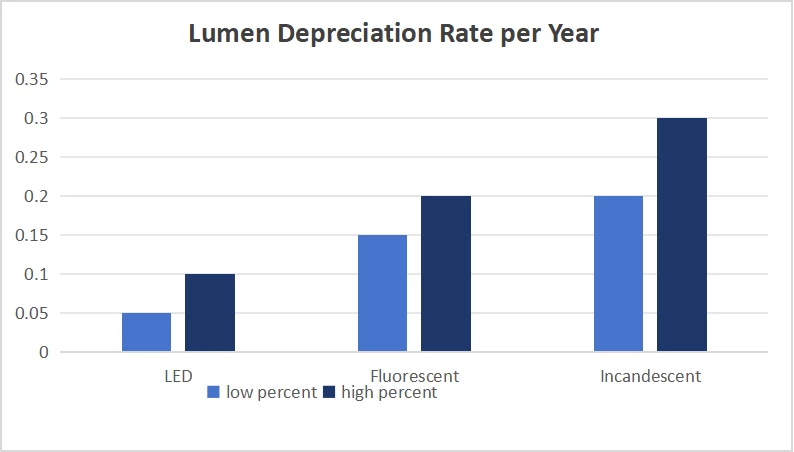
조명 유지 관리 단계
전원 끄기 및 안전
- 유지보수를 수행하기 전에 감전 및 손상을 방지하기 위해 전원을 차단해야 합니다.
- 고도가 높은 조명기구(가로등, 하이베이 조명)의 경우 적절한 보호 및 지지대가 필요합니다.
표면 청소
- 깨끗하고 부드러운 천이나 정전기 방지 천으로 전등갓, 렌즈, 방열판을 닦습니다.
- 강산, 염기성 또는 부식성 세정제를 사용하지 마세요.
광원 및 액세서리 검사하기
- LED 모듈, 튜브 또는 전구의 노후화 또는 손상 여부를 검사합니다.
- LED 드라이버와 밸러스트의 손상 여부를 점검합니다.
전기 연결 검사
- 전선, 플러그, 단자가 느슨하거나 손상되었는지 확인하세요.
- 나사를 조이고 필요한 경우 손상된 전선을 교체합니다.
방열판 및 구조 부품 검사하기
- 방열판에 먼지가 쌓이지 않도록 청소하고 공기 순환이 원활하게 이루어지도록 합니다.
- 고정 장치 하우징, 마운팅 브래킷 및 나사가 단단히 조여져 있는지 검사합니다.
전원 복원 및 테스트
- 전원을 켜고 밝기와 색온도가 정상인지 테스트합니다.
- 스마트 조명기구의 경우 제어 기능(디밍, 색상 조정, DMX 등)을 테스트합니다.
| 유형 | 특징 | 유지 관리 초점 |
|---|---|---|
| 홈 | 저전력, 많은 유닛, 쉬운 접근 | 전등갓 청소, 전구 교체, 스위치 점검 |
| 상업용 | 장시간 사용, 빛의 일관성에 집중 | 균일한 조명 유지, 드라이버 교체, 조명기구 점검 |
| 산업 | 고전력, 열악한 환경, 높은 마운팅 | 냉각 점검, 먼지 청소, 방수 부품 밀봉, 배선 및 마운트 안전 보장 |
결론
결론적으로 조명 유지관리 요소를 이해하는 것은 조명 시스템이 적절한 양의 빛을 제공하고 에너지 효율적이며 수명이 길도록 하는 데 필수적입니다. 유지 관리에 주의를 기울이면 더 나은 조명의 공간을 조성하고 좋은 조명이 가져다주는 모든 이점을 누릴 수 있습니다.
사람들이 자주 묻는 질문
유지보수가 필요한 조명을 끄는 방법은 무엇인가요?
- 전원 차단: 스위치를 끄고 감전을 방지하기 위해 가급적 주 전원을 분리하세요.
- 식을 때까지 기다리세요: 작동 후 램프가 매우 뜨거우므로 식을 때까지 기다리세요.
- 도구: 드라이버, 절연 장갑, 사다리, 보안경.
- 지침에 따라 전등갓이나 하우징을 제거하고 클립이나 나사를 풉니다.
- 플러그인 커넥터 또는 나사 단자를 조심스럽게 분리합니다. 커넥터가 배선된 경우 나중에 쉽게 다시 연결할 수 있도록 표시를 해 두는 것이 좋습니다.
- 램프 제거하기: 램프가 떨어지지 않도록 양손으로 램프 본체를 받쳐주세요.
자주 사용하는 램프는 얼마나 자주 관리해야 하나요?
- 가정용 조명: 일반적으로 6~12개월마다 유지보수를 수행합니다. 여기에는 주로 먼지를 청소하고 전구/LED 모듈을 검사하는 작업이 포함됩니다.
- 상업용 조명: 3~6개월마다 유지보수를 권장하며, 1년에 한 번 정밀 유지보수를 수행합니다.
- 산업용 조명: 긴 작동 시간과 복잡한 환경으로 인해 일반적으로 1~3개월마다 유지보수를 수행하며, 6개월마다 종합 유지보수를 수행합니다.
램프에 정기적인 유지보수가 필요한 이유는 무엇인가요?
조명 설비는 시간이 지남에 따라 먼지와 이물질이 쌓이고 전기 부품이 노후화되거나 느슨해져 조명 품질과 안전에 영향을 미칠 수 있으므로 정기적인 유지 관리가 필요합니다.
정기적인 청소, 점검 및 교체로 조명 기구의 안정성을 유지하고 수명을 연장할 수 있습니다.

